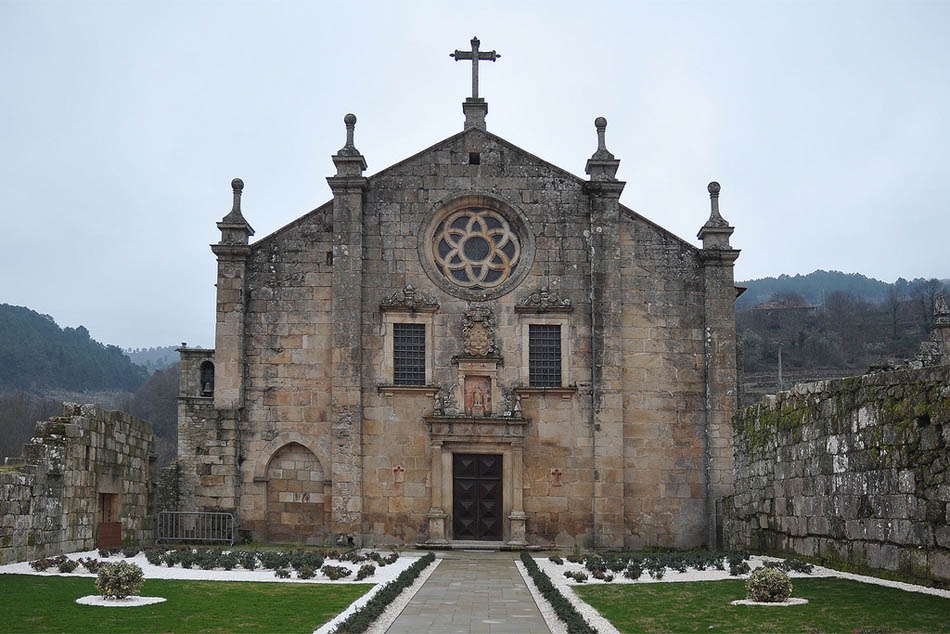We decided that touring the Douro River area was a priority on this trip, more to experience the area and the small towns along the river, than the actual wine aspect. Not that we wouldn’t enjoy that part too!
We were picked up at our apartment by Sandro, our driver for the day. He drove east, by way of a major highway, up into the hills. The scenery was beautiful, although we weren't seeing the Douro yet. We did cross some bridges over other rivers in the area. We went to the town of Lamego, where we met our guide Antonio at the TI. This was the first day of our 3-day tour of the Douro River valley, arranged through Portugal Green Walks.
First stop was an ancient bridge, Ponte Fortificada de Ucanha, where we also stopped in at a little cafe and had a coffee and a taste of berry liqueur.


 |
| Antonio telling Pam about the bridge, Ponte Fortificada de Ucanha |
The bridge was built during the 14th-15th centuries, and replaced another, older Roman bridge.
Next was the monastery of St. John of Tarouca. San Joao de Tarouca, in Portuguese, was the first Cistercian monastery in Portugal. It was founded in 1140 and its construction started in 1154. The blue tiles in the sacristy of the church are spectacular. Next to the church, archaeological excavations between 1998 and 2007 uncovered the foundation of the original medieval monastic dependencies.











We also visited a convent in the area.
Antonio had arranged for us to have a simple lunch of meats, cheeses, bread, olives, and a tasting of some wines.



After lunch we went back to Lamego. We visited the Church of Our Lady of the Remedies, at the top of the famous staircase with 700 steps that led down into the main part of town. There was an elaborate little nativity scene, on permanent display. and there must have been a fireplace somewhere outside, because they sold little wax figures inside the church, similar to Fatima, to offer up requests to the Blessed Mother. There was also a chestnut tree outside of the church said to be 700 years old.








We didn't walk down the 700 steps, but got a ride from Sandro, to visit the cathedral in the main part of town.














At the end of our day of touring, Sandro delivered us to our little hotel, Casa de Casal de Loivos. We were finally seeing the Douro river, and the vineyards stepping up the hillsides.



At the hotel, we were offered a glass of port on the back terrace, as a welcome, and met the other visitors staying there. One group of 4 from Oregon was doing a week-long hiking trip of the area arranged by Portugal Green Walks. Others were driving through the area, and had chosen this little, out-of-the-way hotel, above Pinhao. Dinner was served at a big table in a formal dining room, and included a creamed vegetable soup, cod and potato casserole, salad, and bread. When the manager heard that Gail had just celebrated her 80th birthday, she helped continue the celebration by putting a candle on the dessert cake, and we all sang. I sat next to a German family, and had a nice chat with them during dinner. We've learned two important words or phrases in Portuguese - Obrigada (thank you, said by a female), and BomDia (good morning). We made sure to use our Portuguese at every opportunity.




After lunch we went back to Lamego. We visited the Church of Our Lady of the Remedies, at the top of the famous staircase with 700 steps that led down into the main part of town. There was an elaborate little nativity scene, on permanent display. and there must have been a fireplace somewhere outside, because they sold little wax figures inside the church, similar to Fatima, to offer up requests to the Blessed Mother. There was also a chestnut tree outside of the church said to be 700 years old.








We didn't walk down the 700 steps, but got a ride from Sandro, to visit the cathedral in the main part of town.














At the end of our day of touring, Sandro delivered us to our little hotel, Casa de Casal de Loivos. We were finally seeing the Douro river, and the vineyards stepping up the hillsides.



At the hotel, we were offered a glass of port on the back terrace, as a welcome, and met the other visitors staying there. One group of 4 from Oregon was doing a week-long hiking trip of the area arranged by Portugal Green Walks. Others were driving through the area, and had chosen this little, out-of-the-way hotel, above Pinhao. Dinner was served at a big table in a formal dining room, and included a creamed vegetable soup, cod and potato casserole, salad, and bread. When the manager heard that Gail had just celebrated her 80th birthday, she helped continue the celebration by putting a candle on the dessert cake, and we all sang. I sat next to a German family, and had a nice chat with them during dinner. We've learned two important words or phrases in Portuguese - Obrigada (thank you, said by a female), and BomDia (good morning). We made sure to use our Portuguese at every opportunity.



No comments:
Post a Comment